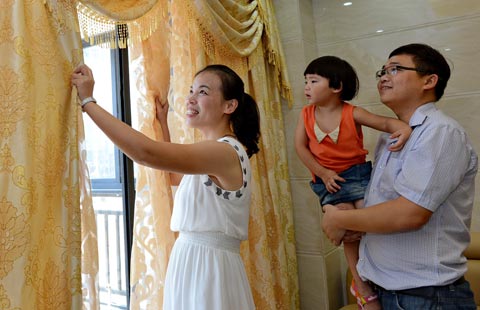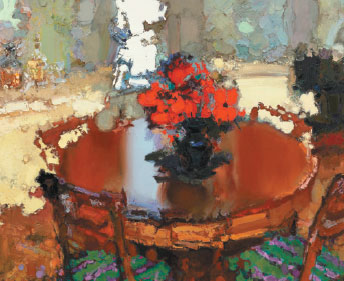Narrative in oil
Updated: 2014-08-05 07:20
By Lin Qi(China Daily)
|
|||||||||||
Ever since Chinese artists started to paint with oil a century ago, they have been exploring how to translate the Western art form in the context of their own culture.
Today, a large number of artists work with oil, and their approaches vary from the realistic to the abstract. Their techniques are more mature, and their works sell well in galleries and at auctions.
An ongoing exhibition at the Shandong Art Museum critiques the dynamics and problems of Chinese oil painting, addressing issues such as the repositioning of oil painting and the core spirit of painting.
My Homeland, My People, an exhibition series reviewing modern and contemporary Chinese oil painting, brings its last show of about 247 works, including dozens of landmark works from museum collections to Jinan, capital of Shandong province.
The show opened on July 25, marking the anniversary of the death of Zhu Naizheng (1935-2013), an artist and educator who spent much of his career establishing the vocabulary of Chinese oil painting.
Zhu launched My Homeland, My People five years ago to curate exhibitions and academic forums in six cities that represent different cultural features of China.
The exhibition examines how painters in Central China - including two cities and four provinces - integrate oil paints with the region's rustic texture and deep-seated traditions.
Members of the organizing oil art council under the China Artists Association say they did not select works that were perfect, but sought to underline the artists diverse expressions of human nature.
Dai Shihe, director of the oil painting department at the Central Academy of Fine Arts, says more painters have learned to use delicate brushwork, and have moved away from the highly stylized approaches that dominated Chinese oil painting for decades.
"Artists are less superior and their works are more down-to-earth. The art community has sought to incorporate talented people and creative ideas from the grassroots," he says.
The exhibition doesn't intend to dodge the immaturity in presentation and influences of commercialization that some of the works on display have fallen victim to.
"Many works are deficient in profiling and color application, which indicates a lack of extensive understanding of oil painting's temperament," says Shang Hui, managing editor of CAA's monthly magazine Fine Arts.
The exhibition also shows the impact of commercialized tastes, for example, many of the paintings are large in size, and many embrace similar motifs, such as migrant workers and xiaoqingxin girls (loosely translated as young women who are inspired by good literary works).
Oil painter Chao Ge says he is most impressed by Still Life which Chang Shuhong (1904-94) painted in 1942 and is among the few smaller-sized works on display.
"The painting exudes calmness and powers that have survived the passing of time," he says.
"I have seen a lot of good contemporary works in the market, but I just can't feel the spark, the energy."
He says art has evolved into varieties of forms, and painters are struggling to reposition the role of painting. He says only those who can "feel the pulse" of time will succeed.
Zhang Jingsheng, a professor with Tianjin Academy of Fine Arts, believes the pulse of time is above all "the essence of human nature". He has striven for six decades to create works that touch upon humanity, coupled with making and correcting mistakes. For years he painted realistic history themes and Dunhuang fresco-inspired works. His latest abstract series Red Flowers on Table is on display at the exhibition.
"I will never agree with the statement that painting will die because people today can't continue its past glories," Zhang says.
"An artist's ultimate goal doesn't have to be the repetition of past excellence. Instead, he paints to inform people of the values that have gone unnoticed, and that the wrong may be right."
|
Red Flowers on Table, by Zhang Jingsheng in 2013, is displayed at the My Homeland, My People exhibition in Jinan. Provided to China Daily |

(China Daily 08/05/2014 page19)
Today's Top News
NATO to offer tailored support to Ukraine
Babies bob about in water at US's first baby spa
News website staff face extortion probe
China's meeting on 13th five-yr plan
Number of visitors to China drops
Export of mooncakes on the rise
Putin outlines ceasefire plan for Ukraine crisis
China paves way for sports investors
Hot Topics
Lunar probe , China growth forecasts, Emission rules get tougher, China seen through 'colored lens', International board,
Editor's Picks

|

|

|

|

|

|






